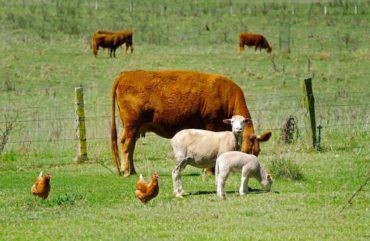 Whether organically grown meat and poultry is a healthier choice for home consumers is a complex and controversial subject.
Whether organically grown meat and poultry is a healthier choice for home consumers is a complex and controversial subject.
There is no question that organically grown livestock and poultry can be healthier for the environment. The farming practices employed by farmers who grow animals without the use of pesticides on pastures and purchase organically grown feed are extending the protection of soils and watersheds from pesticide pollution. Organic and sustainable farming methods also employ good grass-pasturing rotations and natural fertilization utilizing animal manures.
The question of antibiotic use in organic or conventionally raised livestock and poultry is another matter. Myth, misunderstanding and controversy surround the subject of animals being treated with antibiotics, and the effect of antibiotics on humans.
One topic in question is whether antibiotics fed to animals to prevent infection or to treat a sickness contributes to antibiotic resistance in humans. We do not consume meat containing antibiotics directly because there are strict rules enforced by the U.S. Department of Agriculture (PDF) and the Food and Drug Administration that dictate how those drugs must be used in the food industry.
The problem arises because the animals being treated with antibiotics develop resistant bacterial strains in their guts. Should the meat be contaminated with those bacteria at time of slaughter and not handled properly in the butchering, packaging and eventually the food-preparation process, it is possible for a human to ingest those bacteria.
Someone with a compromised immune system such as a young child or an elderly or ill person could potentially sicken from the resistant bacteria and consequently may not be successfully treated with antibiotics.
Organically grown livestock and poultry is generally pasture fed, and any supplementary feed must be with organically grown.
Bovines, which include all hoofed animals, are ruminates, meaning their natural food is plant based. They they chew, regurgitate and chew again to mix the food with their saliva, which begins the digestion process.
Poultry can thrive entirely on pasture, eating grass and pecking for bugs, slugs and worms. Pigs are omnivores and organically raised pork is also pastured and supplemented with organic grains and dairy surplus such as whey.
If an organically raised animal becomes ill or diseased and must be treated with antibiotics, it must then be marketed outside of the organic food stream.
There are controversial discussions as to whether concentrated animal feeding operations (CAFO) are appropriate for producing livestock and poultry for the marketplace. Some feel that CAFOs degrade the environment, are detrimental to the animals themselves and are generally unhealthy, as disease is more easily spread in a crowded environment.
The Center for Disease Control (CDC) and the National Association of Local Boards of Health (NALBOH) have grave concerns about the negative impact these huge feeding operations have on communities. In a comprehensive study, they stress the importance of using best management practices to insure healthy meat products and minimal negative impact on air quality and water safety for nearby communities.
The other side of that argument is that raising a large number of animals in a concentrated space uses less land and labor, costs less and produces a higher yield per dollar spent. Proponents of organic and sustainably raised meat sources argue that pasturing animals on grass is the way they are meant to live, and when well managed, free range is better for the environment.
The difference in nutrition between battery-raised chickens and free-range, organically raised chickens is in the Omega 3 and fat levels of the meat. The same is true of grass-fed beef and pork. Animals that wander and forage are leaner, and their diets contain healthy grasses and grains that grow in their environment.
Basically, whether you buy organic or conventionally grown livestock and poultry is a matter of personal choice. Availability of locally grown, sustainably grown and organically grown meat may be limited — and low grocery store prices on CAFO meat can be very appealing.
The important point is to purchase the highest quality you can afford, take safety precautions in the home kitchen, and enjoy the nutritional benefits of good, healthy food — and follow the advice of food writer Michael Pollan, “Eat food. Not too much. Mainly plants.”
READ MORE IN THIS SERIES• Why Buy Organic? Part 1: Fruits and Vegetables
• Why Buy Organic? Part 2: The Dirty Dozen and the Clean 15!
• Why Buy Organic? Part 3: Top Reasons to Consider Buying Organic Meats and Poultry
• Why Buy Organic? Part 4: Seafood

























